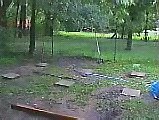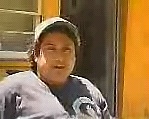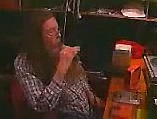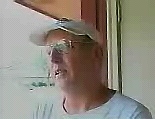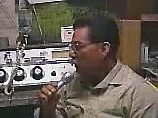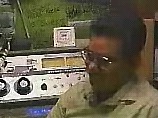Note: Clicking on any bordered pictures in this feature spawns a clip from the documentary
Real Player required
The last time someone chronicled the story of free radio in the United States on video or film was Pump Up the Volume, and before that there was only one DIY-style video out there, which has long ceased production and distribution.
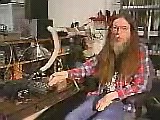 The story of modern microradio had yet to be told; enter Kevin Keyser, a field producer working in mainstream TV news on the West Coast. He once did a story for his station on Stephen Dunifer and Free Radio Berkeley and was intrigued by the concept of unlicensed broadcasting. Unfortnately, the story that ultimately aired didn’t do Dunifer justice – as was the problem with much of the news Keyser found himself covering. It wasn’t his fault, though – it was the medium’s.
The story of modern microradio had yet to be told; enter Kevin Keyser, a field producer working in mainstream TV news on the West Coast. He once did a story for his station on Stephen Dunifer and Free Radio Berkeley and was intrigued by the concept of unlicensed broadcasting. Unfortnately, the story that ultimately aired didn’t do Dunifer justice – as was the problem with much of the news Keyser found himself covering. It wasn’t his fault, though – it was the medium’s.
“I would sometimes spend an entire day with people and then see it boiled down to a 2 minute story on our show that night that just barely scratched the surface,” says Kevin.
Having previously realized a penchant for documentary films, Keyser was intrigued enough by his day with Dunifer to dig deeper into the microradio movement.
The story got more compelling, and in July, 1999 Keyser set out with a brand-new digital video camera and a mission – to chronicle the stories of the free radio movement across the country, in hopes of explaining what it is that makes radio pirates defy the law.
 Free Radio: A Documentary was put together with less than $5,000 and a home computer. “There is no way this would have been possible [10-15] years ago,” Kevin says. He hired a cameraman to help him cover one event, but the rest he shot himself.
Free Radio: A Documentary was put together with less than $5,000 and a home computer. “There is no way this would have been possible [10-15] years ago,” Kevin says. He hired a cameraman to help him cover one event, but the rest he shot himself.
Chronicling the Rise
The documentary, as a history of microradio from the late 1980s to early 1990s, is remarkably complete. Keyser visits with the true father of U.S. free radio, Mbanna Kantako, who’s been running Human Rights Radio in Springfield, IL straight on since 1986.
Kantako is legendary for his accomplishment – running a station for so long and in such open defiance that it boggles the mind. What began as a way to shed some light on police brutality in a housing project isn’t just a station anymore. It’s branched out into after-school programs and true community improvement for the African youth of Springfield.
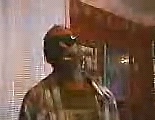 “He has been evicted, arrested, etc., and his family has been continually harassed by local authorities. Somehow, through all of this, he has managed to keep his course and go on the air every night and not let these people intimidate him. He’s also a real character and a funny guy,” says Kevin.
“He has been evicted, arrested, etc., and his family has been continually harassed by local authorities. Somehow, through all of this, he has managed to keep his course and go on the air every night and not let these people intimidate him. He’s also a real character and a funny guy,” says Kevin.
Also included are perspectives on the movement from other instrumentals like Stephen Dunifer of Free Radio Berkeley, “Captain Fred” of Berkeley Liberation Radio, “Skidmark Bob” from Free Radio Santa Cruz, and two members of Free Radio Austin – just to mention a few from an incredibly diverse cast of rogue radio personalities.
One Keyser thinks especially highly of is Micro KIND Radio in San Marcos, Texas. Run by Joe Ptak and Zeal Stefanoff, the station ran 24-7 in two-hour increments, with the microphone open to all, until it was silenced by court order in September, 2000.
“I especially like how KIND Radio does things and allows everyone, even the [Ku Klux] Klan, to be on the air. Free speech is all about protecting all kinds of speech, especially the most unpopular speech,” he says.
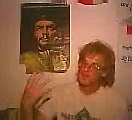 Getting Both Sides
Getting Both Sides
Free speech may be a primary force that spurs free radio activists into action, but there’s lots of other reasons, too. Corporate control of the airwaves is a huge beef. And pirates have been known to take their beefs straight to the source, as evidenced by protests at FCC and NAB Headquarters and at the NAB’s annual conventions.
These “bad guys” make an appearance on Free Radio, too, and reveal themselves for what they are. Keyser discovered a snippet of a Fox News interview conducted with Stephen Dunifer and Tom Star from Talk America radio networks, who was speaking on behalf of the radio industry. In the clip, Star tries to argue that pirate radio hinders free speech, and, in the process, subliminally admits that the broadcast industry stifles it.
 “I like that clip. It’s seems to get the biggest laughs when a crowd is watching it,” says Kevin.
“I like that clip. It’s seems to get the biggest laughs when a crowd is watching it,” says Kevin.
Other spokesmen from the NAB and FCC are also consulted for their perspectives, if only for the sake of balance. “I basically flew to DC without either one saying, ‘Yes.’ I guess perseverance and a bit of stalking might have helped,” Kevin muses.
 Up-to-Date
Up-to-Date
The “director’s cut” of Free Radio was finished in March, 2000, and was released in its final edited form later that year. That gave Keyser the perfect opportunity to probe some pirates’ minds into the future of free radio following the passage of the FCC’s LPFM rule.
Some active pirates were quick to admit they would continue broadcasting without a license. Part of the reason is ideological: “A lot of people don’t like the idea of being ‘licensed’ at all by the FCC, because if they can give you a license, they can also take it away,” explains Keyser. “Some people, like Mbanna & Stephen Dunifer, don’t want the government regulating them or what they can say on the airwaves in any way.”
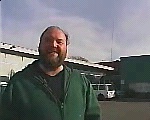 Part of the problem is, those who were most vocal were excluded from the new LPFM game precisely for speaking out. The FCC disqualified pirates from holding licenses. “These people are the ones who really pushed this issue into the limelight and made LPFM happen. It’s a really bad decision by the FCC,” he thinks.
Part of the problem is, those who were most vocal were excluded from the new LPFM game precisely for speaking out. The FCC disqualified pirates from holding licenses. “These people are the ones who really pushed this issue into the limelight and made LPFM happen. It’s a really bad decision by the FCC,” he thinks.
In the end, look for the movement to remain alive and well – and loud. “I think (free radio) will continue to grow as people get more and more fed up with the boring crap they are fed by the mainstream, corporate media outlets,” Kevin says.
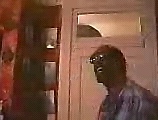 If you want to know why, the answer is now only a videotape away. Keyser says many people have requested it be played on their local cable public access channels. It’s been shortened substantially from its hour and 45 minute original length and two separate versions will be available (one specifically about Mbanna Kantako and the other about the movement as a whole).
If you want to know why, the answer is now only a videotape away. Keyser says many people have requested it be played on their local cable public access channels. It’s been shortened substantially from its hour and 45 minute original length and two separate versions will be available (one specifically about Mbanna Kantako and the other about the movement as a whole).
If you are interested in getting a copy of Free Radio: A Documentary, email Kevin Keyser, or buy online direct from BuyIndies.com. It’s well worth it.
More Clips
Micro Kind Cuts
